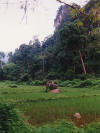|
rice
Edible crop cultivated and eaten principally in Asian
countries. There are several species including
glutinous or sticky rice, known
in Thai as
khao
niauw (fig.)
and black rice (fig.).
One specific strain of rice, the fragrant
jasmine rice, is so popular that it
has been patented by
Thailand to prevent other countries from using its
name. With the exception of plantation and mountain rice (fig.) it is grown in paddies
deluged with water (fig.). Rice cultivation starts in a specific prepared corner of
the basin where rice seeds are sown in the beginning of the rainy season. After
about 45 days, when
the first crop of rice sprouts or ‘ton
klah’ reaches a height of 20 to 30
centimeters, these are uprooted and tied into bunches to be moved (fig.). The sprouts are then
cut at the top and transplanted apart from one another in more spaciously rows throughout the
remainder of the field, in small groups of about 3 to 5 seedlings,
a process known as ‘yaay
ton klah’ (fig.). Not all rice
matures at the same time and depending on its variety and external factors it
may be harvested up to three times a year (although two is more likely), except
for plantation and mountain rice which has usually only one yield annually. The
quality of the rice is graded (fig.) according to the variety and its time of ripening,
distinguishing between early, middle and late matured rice, and off-season rice
or ‘khao nah prang’ when produced after the rainy season or on poor-grade paddy
land with too much water. Good quality rice is called ‘khao nah suan’ and comes
from farms called ‘nah dam’ on which transplanting of paddy seedlings is
practiced, as distinguished from farms called ‘nah wahn’ on which paddy is sown
without transplantation. Throughout the time of
ripening the paddies will be kept flooded with water. In hilly or mountainous
area rice paddies are either terraced (fig.) and
deluged with water (fig.),
or so-called mountain rice is grown, a variety of rice which cultivates in less
humid soil on mountain slopes. By harvesting time the rice will have turned
yellowish gold and the ears of rice are hand cut with a crescent shaped rice
cutter called
kiyaw (fig.). It is then threshed
in order to separate the seeds or grains from the straw, an activity traditionally done
by either trampling the rice beneath
the hooves of a water buffalo that is made to walk in circles, or by beating the grains out on the
ground (fig.),
on a threshing board (fig.)
or threshing bench (fig.),
or into a large basket
called
piyad
(fig.),
by holding a bunch of ears between two sticks tied together with
a piece of rope, a tool known as
mai faad
khao (fig.). Subsequently the
loosened grains are milled in a
krok sih (fig.)
or pounded in a
krok tam khao (fig.) and then winnowed in flat, round
baskets called
kradong (fig.), to remove the chaff.
A threshing machine (fig.)
combines these actions by separating the grain from the stalks as
well as from the husks. For larger quantities the rice is brought to
a
rice mill (fig.)
where it is not only polished, but also sorted, according to
size, quality,
harvest
period,
etc. Thailand produces an average of
around 15 million tons of rice per year making it the world's leading exporter.
It has since long been known as Southeast Asia's rice bowl and in ancient
Sanskrit literature the area of Thailand was referred to as
Suvarnabhumi,
the Land of Gold, after the many rice fields which turn yellow-gold when ready
for harvesting. Bundled ears of rice are in Thailand often used
as decoration, literally (fig.)
as well as in
iconography
(fig.),
whereas in
Myanmar, bundles of
yellow-golden ears of rice are sold by
itinerant street vendors
(fig.),
with the intent for it to be
offered to the birds (fig.)
as a form of merit making. After the harvest, often slash and burn
techniques are used to clear the fields from the remaining stalks by
setting them on fire (fig.).
The process is easy and frees the farmers of doing the labourious
task of clearing the field themselves, while the ashes provide free
fertilizer. Though illegal, laws are hardly ever enforced as it hard
to police. Violations usually occur in remote areas, while it would
generally be hard to pinpoint and proof the actual cause, as well as
the instigator of such a fire. Pests or natural enemies to rice include
Apple Snails
(fig.),
that lay their eggs on
the stalks of rice plants (fig.),
Cereal Leaf
Beetles (fig.), and
Rice Weevils (fig.),
that infest stored rice crops. In Thailand, as in many Asian
countries where rice is often the main food staple, friends and
strangers alike are informally greeted by posing a question to find
out if one has already eaten. In Thailand, where rice is called
khao, one is
asked
kin khao reua yang, while
in Myanmar,
one is similarly asked
thamin sa bibi la,
and in
China,
chi fan le ma, all
literally meaning the same, i.e.
‘have you eaten rice yet?’. These questions are usually rhetorical
in nature, and posed in order to show an interest in the other
person's wellbeing, rather than a nosiness into someone's actual
eating habits or an invitation to a meal.
See also THEMATIC STREET LIGHT (1)
and
(2),
and
WATCH VIDEO (1) and
(2),
and
VIDEO (EN).
回






|

